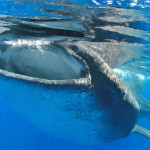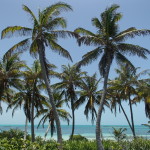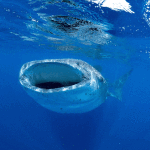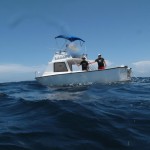
Industrial fishing operations take most of the blame for collateral impacts to sea-turtle populations, but new research shows that small-scale fisheries–operated by hand from little open boats –can kill as many critically endangered loggerhead sea turtles as industrial scale fisheries. A pioneering case study conducted on small-scale fisheries at Baja California Sur, Mexico found that small scale artisinal fisheries in Baja California Sur can kill 1000 sea turtles per year, and possibly many more.
Local fishermen ply these waters for halibut and other bottom fish using gillnets and strings of hooks known as longlines. Their pangas–small, open boats around 25 feet long– usually fish within about 3 miles of shore, where there are few turtles. But when the fishermen venture farther offshore they share the water with thousands of turtles that spend years fattening up on the abundant food.
“Small-scale fisheries and their impacts have been overlooked because they are inherently difficult to study,” said Hoyt Peckham, a PhD Canidate in ecology and evolutionary biology at the University of California, Santa Cruz. But Peckham and colleagues partnered directly with local fishermen to simultaneously assess and mitigate small-scale fisheries bycatch.
It’s important to stress the conservation side of the story, says Wallace J. Nichols, Ocean Conservancy Scientist. He calls the partnership between scientists and fishermen a conservation success. Local fishermen are moving forward with protections ahead of the government. They are using this new information to create a refuge.
“Many small-scale fishing operations off the coast of Baja, Mexico overlap with high concentrations of loggerhead turtles. The combination of the indiscriminate gillnets and long-line fishing gear and the density of loggerhead turtles results in a deadly situation for the turtles,” said Nichols. “Local efforts to educate fishermen and remove dangerous fishing gear from the water are essential to protecting this endangered species that relies on the food-rich waters in Baja, Mexico for survival.”
By comparison, officials in the United States are so concerned about the same North Pacific loggerhead population that in 2002 they shut down Hawaii’s $55 million/yr swordfish fleet to develop ways to avoid bycatch. The fishery reopened three years later with assorted bycatch solutions and included a bycatch cap whereby if the fleet as a whole catches 17 turtles, the fishery is closed until the following year. In 2006, the cap was reached and the fishery was closed just three months into the 10-month season.
“That’s just a huge fishery, shut down completely, to protect loggerheads based on strong conservation science ” Peckham said. “But ironically, we’ve routinely seen more than 17 turtles caught per day, by a single skiff–more turtles than are allowed for the entire Hawaii longline fleet in a whole year.”
Baja California Sur is a biological ‘hotspot’ for marine species including loggerhead turtles, blue whales, swordfish, striped marlin, and yellowfin tuna. The source of the aggregations is thought to be an abundance of the red crab Pleuroncodes planipes in upwelled water. The red crabs can advect far offshore in the currents, reaching high concentrations in sea surface temperature fronts off the peninsula. Highly migratory species travel from afar to feast on the red crabs, but loggerhead turtles can linger offshore for several years before moving on,… or meeting their demise.
A link to more on this story can be found at http://www.seeturtles.org
Photo credit: Wallace J Nichols, Ocean Conservancy.





